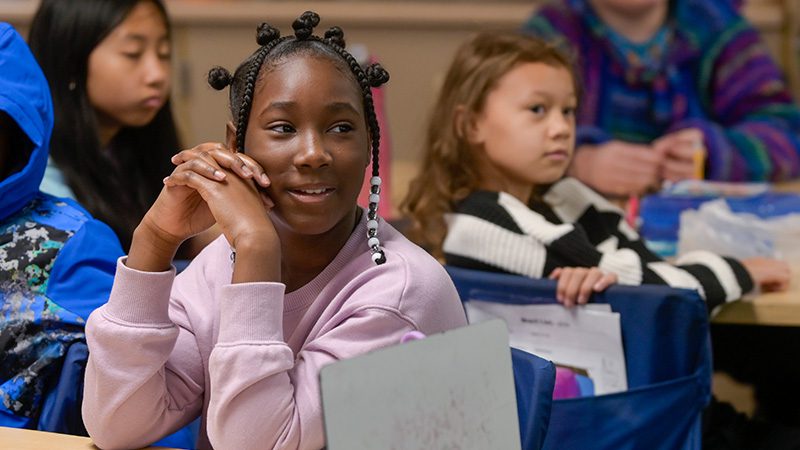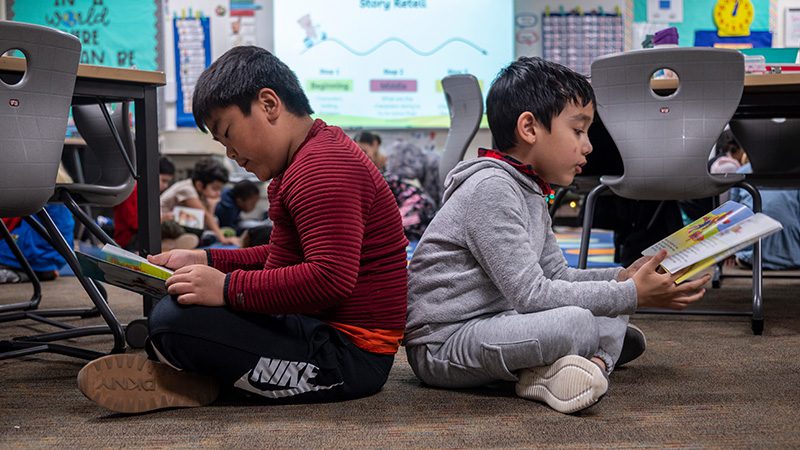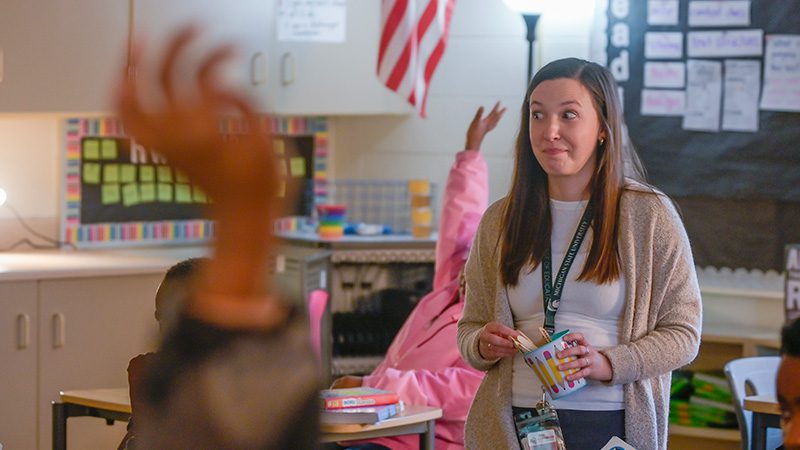Challenger Elementary
Challenger Elementary’ s Culture of Caring Captures Kids’ Hearts and Minds
By Cassandra Spratling
As students arrive at school, Principal Teressa Gatza is outside Challenger Elementary School happily welcoming students. She seems to know each student by name as she greets them with a high-five, a “Good morning,” a positive pep talk…or all three! “Make it a great day,” she says to one, while fist-bumping another and telling yet another, “Be amazing!” In between greeting students, she chats with parents as they drop off their kids. She calls this morning ritual the best moment of every day.
It sets the tone for the day. “It matters when children know you’re excited and happy to see them upon arrival,” she says. And it doesn’t stop there. Inside the building, teachers stand outside their classrooms, smiling, hugging, and greeting their students with a demeanor that is as bright and cheery as the colorful walls of their classrooms.
“This is very intentional,” says Gatza, who’s in her 8th year as principal of the school in Kentwood, MI., which borders Grand Rapids. Making certain students feel good about being in school sets a foundation for learning that’s key to building the success of the school’s approximately 360 students in grades K through 5. “Kids don’t learn from people they don’t like.”
The majority of students at Challenger come from low-income households and are students of color. And it’s among that very population that Challenger shows remarkable progress, making this school a true outlier in the state. While students’ scores are not yet where school leaders want them to be, The Education Trust-Midwest’s analyses show consistent and above average growth in math and English Language Arts, notably for students from economically disadvantaged backgrounds, Black students and English Learners.
The formula that leads to the school’s results is intentional. It includes assessing where each student stands academically and targeting instruction and support to bring them up to or beyond grade level. But everything starts with making sure each student feels recognized and cared for.
“We believe in making sure all students have a strong sense of belonging at Challenger and that all students feel seen and heard,” Gatza says.
The culture of caring that’s evident throughout the school builds on a national initiative the school has utilized for the past several years called, “Capturing Kids Hearts.” Their implementation of the program has led Challenger to be recognized as a Capturing Kids Hearts National Showcase School for the past five years in a row.
We believe in making sure all students have a strong sense of belonging at Challenger and that all students feel seen and heard.”
Principal

The philosophy starts as soon as students walk through the door, carrying over to the welcoming morning routine and is woven through to classroom practices.
For instance, before third grade teacher Heather Cobb begins the day’s lessons, the students gather together on the floor. Cobb asks who’d like to share good news. Several hands go up. She calls on one by tossing a soft, stuffed, squishy yellow toy called “Mr. Lemon” to the child. That child tosses it to another after he shares, and then it goes to another, as several students joyfully tell their good news.
“My mother’s going to graduate soon; she’s going to school to learn to do hair,” says one student. “I get to play with my cousins this weekend,” says another. “I’m going to the park after my (dentist) appointment,” says another.
Building strong relationships between the teachers, students and parents is among six non-negotiables infused in Challenger’s culture and displayed prominently on the school’s website. The others are:
- Infuse hope.
- Celebrate our cultural mosaic as a unifying strength. About 20 different languages are represented in the student population.
- Inspire and insist upon individual and organizational excellence.
- Maintain focused attention and relentless forward progress.
- Target academic objectives, programs, and strategies that are few in number and deep in impact.


-
Formative assessment, which encourages students to share their learning with one another as they progress from one unit or standard to another.“As we teach grade level units in math and reading, we collect data throughout the unit to determine if students understand the standards,” said Kristine Meister, academic support coach for Kentwood Public Schools.It’s a model used districtwide: the teacher demonstrates a lesson; the students and teacher review the lesson together; the students do the task alone with oversight from the teacher—sharing their understanding or lack thereof; and finally, each student works alone to demonstrate understanding of the task at hand.
“It is important to ask students to demonstrate the standard in a variety of ways, such as using evidence to support a multiple-choice question, selecting all answers that apply, writing a short answer, sorting information, evaluating an answer to determine if it is correct, etc. Many of these experiences take place during productive group work, allowing students to talk with each other to explain their thinking. This is when deep understanding takes place.”
-
Small group instruction. Class schedules are designed so that all students have at least 45-minute blocks daily to work in small groups, either in the classroom or in pull-out sessions outside of the class. Generally, students in grades 1-3 receive small group support for 45 minutes per day.Students in grades 4-5 receive push-in support based on needs during guided reading instruction.Groups are set up based on performance on a variety of measures, including English proficiency exams and national and state exams given at various times throughout the school year.The small group instruction allows the staff to tailor instruction to individual student needs. So, while most will work in small groups during designated times, a student may also receive one-on-one instruction from an English Language instructor.
For example, during a recent small group session at Challenger, three students sat on comfy, colorful cushions and pillows on the floor of the English Learners (EL) room, a large colorful spacious room bordered with flags from different countries. While EL Teacher Jessica Surdam sat with them in the front of the room as they read a story together, another EL interventionist Megan Hayes worked one-on-one at a table in the back of the room with a newer student from Honduras who speaks Spanish at home.
Surdam’s group of three third graders represented three different languages. One student was born in Uganda speaking Kinyarwanda. Another was born in Myanmar and speaks Burmese at home. The third student was born in America but speaks Nepali at home. Before the students read the book, “A Row of Lamps,” about the Diwali holiday. Surdam asked questions to determine how much they already knew about the religious holiday, sometimes referred to as the festival of lights, celebrated by Hindus, Jains, and Sikhs. During that discussion, the Nepali-speaking student shared information she knows about Diwali tradition, proudly serving as an unofficial fact-checker.
“We want all students to feel proud and comfortable about their culture,” Surdam says later, explaining that she uses books and other literature that shows characters with lots of different backgrounds and ethnicities. “We validate and celebrate differences.”
In that way, the school recognizes the benefit of honoring students’ cultures and having their experiences mirrored in their instruction.
“A few ways we do this is by choosing culturally responsive texts in our reading series, filling our classroom libraries with texts with people that look like them, highlighting Black people in our world that have positively contributed to our society in a variety of roles,” Gatza says. “We have also participated in a series of professional development where we look at our own biases, engage in conversation around race and ethnicity, and recently we started working through equitable grading practices.”
-
Data Driven. In addition to state and national assessments, Challenger students are assessed three times a year with a computer assessment called iReady.The assessment gives teachers feedback in a variety of areas, including vocabulary, phonics, and comprehension.
Teachers use the data to set up small groups and regularly monitor progress. Teachers also do daily checks to see whether students are meeting standards and where improvements need to be made.“We have recently created unit assessments for our Guided Reading units that will be given at the end of a unit to determine overall proficiency of standards taught in that unit,” Meister said.
-
Teaching grade-level standards for all students. “As we work to fill holes in student understanding, we want to teach grade-level lessons with scaffolds, so we don't end up digging new holes while filling existing holes,” Meister said. “Scaffolds can include supportive partners, front-loading vocabulary, building background knowledge, and sometimes teaching a lesson from a previous grade to teach a prerequisite skill.”In other words, teachers work to ensure students understand the grade-level standard being taught rather than lowering the standard. Dedication to teaching grade-level standards to all students aids Challenger’s progress with all students.These strategies are buttressed by a core belief that all students can learn.
“I'm never writing off a student. And this is also culture-wide, or school-wide, [it’s] definitely how we feel,” third grade teacher Heather Cobb says. “I really bring that every day to the table. Every kid is capable of growth, and they show it in different ways.”